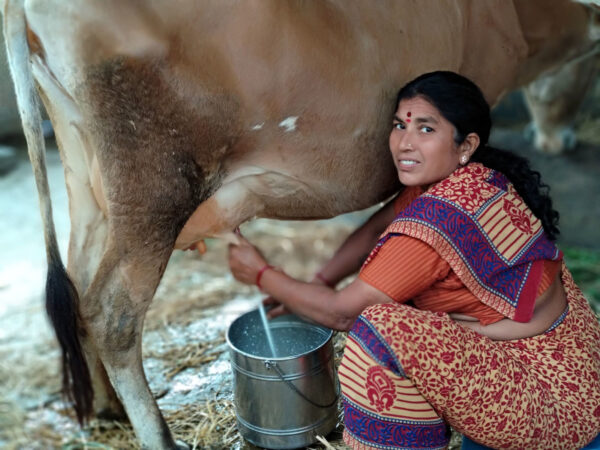Women play multiple roles in the food economy, from participation in crop production or production of milk and eggs to cooking and serving food within the household. While women’s work in economic activities such as livestock rearing is officially part of national income, the time spent by women in activities around the household food economy is rarely recognised. In two villages of Karnataka, we found that women spent around 4-5 hours a day in collecting water, cooking, serving food, feeding children, washing up utensils, and other chores related to ensuring food for the family. The time spent in ensuring food on the table for the family varies depending on access to water and fuel, the number of persons in the household, the type of food cooked, presence of children, and so on. There are three unchanging and essential features of time spent by women in the household food economy: it is unpaid, it is daily, and it is a significant part of the day.

A woman in Karnataka’s Alabujanahalli milking her cattle (FAS PARI Archives)
These findings come from time-use surveys of two villages in Karnataka conducted by the Foundation for Agrarian Studies (FAS) during the agricultural year, 2017-18: Siresandra village of Kolar district and Alabujanahalli village of Mandya district. The two villages had been studied earlier, in 2009 and 2014.
In Siresandra, the first survey was in the lean season (May 12-18, 2017) where 14 women from 10 households were surveyed. The second round was during the harvesting season (December 13-19, 2017) where 12 of the same women were interviewed. Two women had gone to their natal homes for childbirth. In Alabujanahalli village, the first round of time-use survey was during sowing (September 13-19, 2017). A total of 22 women from 10 households were interviewed. The second round with the same 22 women was conducted during the harvest period, January 4-10, 2018. The third round was in the lean season, from May 18-24, 2018. In the third round, only 20 women were interviewed, as one woman had gone to her natal home for childbirth, and another had left for a medical emergency.
We categorised the time spent by women in the food economy into the following activity subgroups: pre-cooking, cooking, serving food, feeding children, cleaning of utensils, collecting water, collecting firewood, and shopping.
Pre-cooking includes cleaning and chopping vegetables or other produce, grinding spices/masala, and any other preparatory work. Cooking refers to preparation of any meals, tea, coffee, snacks, and other items. Then, we counted the time spent feeding children, or serving other members of the family. Cleaning of utensils included washing vessels and plates used for cooking, eating, and drinking (but not vessels used for puja). Collecting water refers to the time spent bringing water in to the kitchen for drinking and cooking purposes only. Collecting firewood for cooking fuel remains important and was identified as a separate category. Lastly, the time spent buying groceries, vegetables and any other food item was included in shopping.
(Note, if there were two women within the same household, there is usually a division of labour, so we have taken the average of the two for both women).
Here are the main results.
In the lean season, in Siresandra village, the average time spent per day (averaged over the week and over all the women) on all food-related activities was 319 minutes or 5 hours and 19 minutes.1
This can be broken up as follows: 148 minutes spent on cooking, 51 minutes on serving food, 40 minutes of cleaning of utensils, 26 minutes on collecting water, 24 minutes feeding children, 23 minutes of pre-cooking, 4 minutes collecting firewood and 3 minutes of shopping. The most important activity time-wise was cooking, followed by serving food and cleaning dishes. Collecting water and firewood varied across the women, depending on access to these resources Shopping was usually done by men and very few women reported going to the stores. Cooking and serving were activities all the women reported, and feeding children, if there were children in the family.
There were variations over the seven days of the survey, with a range from 253 to 333 minutes. And there were variations across women, from 154 to 397 minutes a day.
Let us take the example of Amala, a 27-year-old woman from an Adi Karnataka manual worker household. Her family comprises her husband and two sons. Her husband is a wood cutter, and travels to the neigbouring State for work. Amala is responsible for all activities relating to the food economy and she spend 329 minutes a day or five and a half hours on average during the reference week. She cooks on an LPG stove and prepare at least two meals a day (cooking rice, ragi, sambar, rasam or upsaru, etc.). She collects firewood once or twice a week, and water every day. Water is collected from the tap when it is available or from the nearest pond. Her children were 6 and 8 years old. Her daily work hours varied from 250 minutes a day to 445 minutes a day during the reference week. Her cooking hours ranged from 90 to 210 hours. Some days, more time is required for cooking when there is preparation of dosa batter (though she has an electric grinder), or when she makes ragi ball or non-vegetarian food. On the day she went to buy groceries, she spent 445 minutes in relation to food economy. She went to the market by public bus and the shopping trip took around 3 hours. Her everyday work is generally pre-cooking, cooking, feeding children and collecting water.
Ashwini is 28-year-old, belongs to a Vokkaliga peasant household, and her family comprises her husband, two daughters, and mother-in-law. She does housework, child care, animal husbandry, and tailoring. Her two daughters are 10 and 6 years old. Her husband is a bus driver, and leaves early morning and returns late every day. Her mother-in-law is old and does not help with the household food economy. Ashwini does all the cooking, serves food to the family, cleans utensils, and collects water. During the reference week, she did not go to collect firewood or on a shopping trip, although she is in charge of these activities too.
The daily time spent by her on the household food economy ranged from 4 hours or 240 minutes to 430 minutes. The latter was on a day when she had to cook and feed guests (it was a more elaborate meal with a chicken masala dish). On normal days, she prepares rice or ragi and sambar or tomato gojju (chutney) or groundnut chutney and papad, upma, and puliyogare rice (tamarind rice). Cooking takes up the most time, followed by time spent on serving food and cleaning dishes.
In Alabujanahalli village during the lean season, the average daily time spent by a woman on all food-related unpaid activities was 220 minutes or 3 hours and 40 minutes.2
Of this total, the three major activities were cooking (110 minutes), pre-cooking (30 minutes) and cleaning utensils (30 minutes). The variation across the seven days was form 201 minutes to 251 minutes. The variation across women was higher, from 57 to 514 minutes.
Let us take the case of AG Nagarathanamma, a 42-year-old woman from a Vokkaliga rich capitalist farmer household. She lives with her husband, two sons, and a daughter. She spent 514 minutes a day on average on food-related unpaid activities. Generally, she does pre-cooking, cooking, serving, and cleaning of utensils in food-related housework. The household has tap water. She usually cooks two or three meals a day on an LPG stove. She also cooks meals for hired workers. Her daily food related work hours vary from 360 minutes a day to 635 minutes a day. The day when her work hours rose high, she made papad at home.
Rajamma is a 40-year-old from an Adi Karnataka family, and has a husband, son and daughter. She spends 270 minutes a day on food-related activity. In 2009, her husband and she were manual workers. Now, their economic condition has improved as there are two sources of salaried incomes. Her son works as a librarian and her daughter is a teacher in a convent school. The upward mobility of the household can also be seen from the fact that she was doing non-agricultural labour during the 2009 survey, but had stopped wage work in 2017. They have a pucca house. She does most of the housework, with her daughter helping her at times. She usually cooks three meals a day, like rice, ragiball and sambar, rasam, or soppusaru on an LPG stove. She uses firewood for boiling water. Her daily food related household work hours vary from 40 minutes a day to 480 minutes (8 hours) a day. On one day when she was menstruating, she could not go to the kitchen, and firewood and water had been already collected, so she spent only 40 minutes. She spent most of the day sleeping, as she was suffering from stomach ache.
Chandrakala, a 28-year-old belongs to a manual worker household (of caste Gangamatha) and her family comprises her husband, a son and a daughter. Her son (7 years old) is physically challenged and daughter is 4 years old. She cooks food on a firewood stove. On average, she spends 160 minutes a day or 2 hours 40 minutes on cooking. She generally cooks rice and sambar or ragiball and sambar. Sometimes she cooks akki roti (roti made with rice) and chutney or upma. As she is cooking on firewood it takes lots of time to prepare food. She does not participate in work outside the home as she has to care for her son. She generally does all the household related work, her husband brings the firewood.
To conclude, this exercise attempted to measure the time spent in unpaid activities that are essential to our basic needs, and found that rural women spend, on average, 4 to 5 hours a day, every day of the year, in tasks related to the provisioning of food. This work is unpaid, unrecognised but central to our economy.
1 During the harvest season, the average time spent on all food related activities was 292 minutes or 4 hours and 52 minutes.
2 In the harvest season, the average time spent per day on all food related activities was 231 minutes or 3 hours and 51 minutes.
















































 Sudha is an Administrative Assistant of the Foundation. She assists the administrative division of the Foundation and also has taken part in fieldwork organised by the Foundation.
Sudha is an Administrative Assistant of the Foundation. She assists the administrative division of the Foundation and also has taken part in fieldwork organised by the Foundation.












